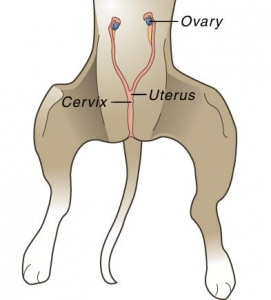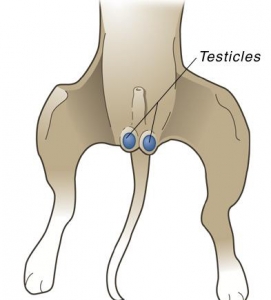Spay & Neuter
SPAYING YOUR DOG

Why should I have my dog spayed?
We recommend spaying all female pets. The benefits to your pet’s health and to help reduce the pet overpopulation crisis make this decision easier. It should be remembered that owners of Guide Dogs for the Blind, Hearing Dogs for Deaf People and Dogs for the Disabled routinely have their dogs spayed. What are the advantages of spaying in the female dog?
- Prevention of heat or estrus
- When in “heat”, the female experiences an urge to escape in order to find a mate. This is eliminated.
- It eliminates the possibility of false pregnancy following the “heat cycle”
- Prevention of uterine infection (pyometra)
- The prevention of breast cancer. Dogs spayed before the first “heat” have less than 0.5% chance of developing breast cancer.
- Elimination of the risk of uterine and ovarian cancer
Is spaying performed for any other reason?
The operation may be performed for several medical conditions. These include:
- Treatment of intractable false or phantom pregnancy
- Females with irregular or abnormal cycles due to ovarian cysts
- Spaying is also carried out on occasions to correct certain behavioral abnormalities
- Treatment of uterine infection (pyometra) or cancer Dystocia (difficult birthing) or post caesarean section surgery
What are the disadvantages?
Most of the perceived disadvantages are false. The most quoted of these are that the dog will become fat, characterless, and useless as a guard. Obesity is probably the most commonly quoted disadvantage of spaying. Obesity is the result of overfeeding. By regulating your dog’s diet and caloric intake, you can prevent obesity in neutered or intact males.
Spaying doesn’t cause a change in personality, guarding instincts, intelligence, playfulness or affection.
When should the operation be performed?
Research reveals that spaying a pet at an early age does not cause any increased risk. Most veterinarians recommend spaying between four and six months of age.
Is there any alternative to surgery?
Not at the present time, although there are several exciting advances being made in this area.
Are there any dangers associated with the operation?
Spaying is considered a major operation and requires general anesthesia. With today’s modern anesthetics and monitoring equipment, the risk of a complication is very low. It has been said that your pet has a greater chance of being injured in a car wreck than having an anesthetic or surgical complication.
What happens when I leave my dog for this procedure?
Your pet will be examined and pre-anesthetic blood tests are usually performed. If everything is acceptable, your pet will then be anesthetized. Most pets will have an intravenous catheter placed to administer the anesthetic and to provide fluid therapy during the surgery. After your pet is anesthetized, a breathing tube will be placed in her trachea (windpipe). This will allow us to deliver oxygen and the gas anesthetic. The surgery consists of making a small incision just below the umbilicus and removing the ovaries and uterus. Many veterinarians use absorbable sutures so that you do not have to return to have them removed.
Are there any post-operative precautions I should take?
Rest and restriction of activity are the primary post-operative care you should provide. Most dogs can resume normal activity five to ten days after surgery. Until then, leash walks, no running or climbing stairs and lots of rest are the rule. I am told that letting my dog have one litter will quieten her down. There is no scientific evidence that having puppies has any calming psychological effect.
NEUTERING
Why should I have my dog neutered?
Neutering should be considered if you are keeping any male dog as a pet. Remember that Guide Dogs for the Blind, Hearing Dogs for Deaf People, and Dogs for the Disabled are routinely neutered.
What are the advantages of neutering my male dog?
Reduces the risk of prostate cancer and prostatitis
Reduces the risk of hormone-related diseases such asperianal adenoma
Eliminates the risk of testicular cancer
Removal of sexual urge which results in less roaming behaviors
Reduction of certain types of aggression

Is neutering performed for any other reason?
The operation may be performed to treat testicular tumors and some prostate gland conditions. It is also used to control hormonal (testosterone) dependent diseases such as anal adenomas.
Neutering may also be used in an attempt to treat certain forms of aggression.
What are the disadvantages?
Most of the perceived disadvantages are false. The most quoted of these are that the dog will become fat, characterless, and useless as a guard. Obesity is probably the most commonly quoted disadvantage of neutering. Obesity is the result of overfeeding. By regulating your dog’s diet and caloric intake, you can prevent obesity in neutered or intact males.
Neutering doesn’t cause a change in personality, guarding instincts, intelligence, playfulness and affection.
When should the operation be performed?
Research reveals that neutering a pet at an early age does not cause any increased risk. Most veterinarians recommend neutering between four and six months of age.
Is there any alternative to surgery?
Not at the present time, although there are several exciting advances being made in this area.
Are there any dangers associated with the operation?
Neutering is considered a major operation and requires general anesthesia. With today’s modern anesthetics and monitoring equipment, the risk of a complication is very low. It has been said that your pet has a greater chance of being injured in a car wreck than having an anesthetic or surgical complication.
What happens when I leave my dog for this procedure?
Your pet will be examined and pre-anesthetic blood tests are usually performed. If everything is acceptable, your pet will then be anesthetized. Most pets will have an intravenous catheter placed to administer the anesthetic and to provide fluid therapy during the surgery. After your pet is anesthetized, a breathing tube will be placed in his trachea (windpipe). This will allow us to deliver oxygen and the gas anesthetic. The surgery consists of making a small incision in front of the scrotum and removing the testicles. Many veterinarians use absorbable sutures so that you do not have to return to have them removed.
Are there any post-operative precautions I should take?
Rest and restriction of activity are the primary post-operative care you should provide. Most dogs can resume normal activity five to ten days after surgery. Until then, leash walks, no running or climbing stairs and lots of rest are the rule.
This client information sheet is based on material written by Ernest E. Ward Jr., DVM.
© Copyright 2002 Lifelearn Inc. Used with permission under license. December 14, 2016.

